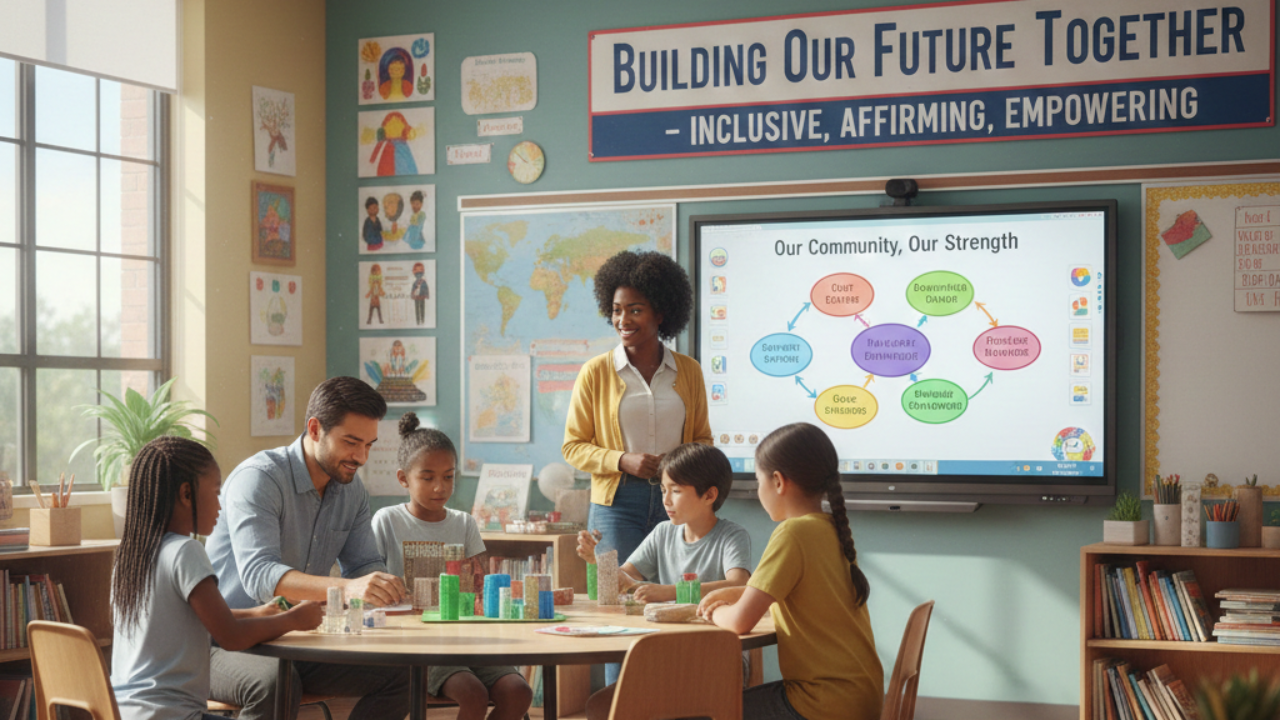5 Surefire Ways to Help Students Succeed in Education's New World
May 22, 2020
Social distancing and school. What does this look like? At the time of this article, who could really tell? Still, even when teachers and school leaders have little idea of what education in a pandemic world looks like, we've got to find ways to help students succeed--both in school and in the virtual world, or in a combination of both.
Understanding that one size definitely does not fit all schools, teachers, and students, we're tapping into some of our best resources, in an effort to bring you 5 ideas and strategies that will help students succeed in education's new world. They'll help teachers, too.
1 -- Ask the right questions. You're an adult, and you're anxious. Everyone is, especially kids. Assume all students are suffering from some kind of anxiety, and ask them questions that show them you understand.
Christine Ravesi-Weinstein, author of Anxious, suggests asking questions like these to students you know are struggling with anxiety:
- Can you tell me how you’re feeling? Even if the way a student is feeling is obvious to you, asking them how they feel empowers the student to speak up and take back a sense of control—a power that, when lost, causes anxiety. Also, their answer to the question will provide you with more insight into the student’s struggles.
- What do you think might be going on for you right now? Clinical anxiety isn’t a feeling that comes on because of one specific, identifiable reason. One issue might trigger anxiety, but typically, anxiety is panic, worry, or discomfort that sets in out of nowhere.
 When it does become debilitating, sufferers are left feeling powerless. When you ask a question like this one, you can help the student initiate a thought process to regain control over the situation, and educate you about a potential solution.
When it does become debilitating, sufferers are left feeling powerless. When you ask a question like this one, you can help the student initiate a thought process to regain control over the situation, and educate you about a potential solution. - What do you need from me? No one likes to be told what to do, especially when it’s unsolicited. But everyone appreciates an offer of help or assistance. Surveying the needs of others and selflessly asking what it is they need from you is a sign of a great leader or “captain.” Expect that the student will most likely answer, “I don’t know,” or “Nothing,” but don’t read into it. They are not being unappreciative of your show of support. Ultimately, they need exactly what you’re doing.
2 -- Discard your traditional grade book. Consider what Starr Sackstein, author of Hacking Assessment, says about traditional grade books:
Averaging grades diminishes student learning to one number. Traditionally, the teacher does all of the tracking privately. There isn’t adequate space in a grade book to write down important anecdotal information. By changing the way we track progress, we re-emphasize the partnership of learning between students and teachers.
Rather than placing arbitrary numbers, letters, and other labels on student work, create a conversation about learning, using in-person and digital feedback. Starr recommends changing your vocabulary like this:

Once you make learning a conversation, it's easy to de-emphasize and, ultimately, completely discard grades. Using a tool like Floop can help students capture their work and share it with peers and teachers, in order to create a feedback loop, en route to mastery learning.
3 -- Build a student support network. Now, more than ever, students need support. They need support from teachers, parents, and from their peers. Now, more than ever, they need support both in school and at home.
According to James Sturtevant, author of Hacking Engagement and Hacking Engagement Again:
Students often experience anxiety about their work. Although we all need to confront challenges to grow, facing overwhelming challenges alone can make a person feel alienated. It’s counterproductive to struggle with a problem in isolation, and devastating to do so while everyone else seems fine. Students need to be assured that if they are feeling anxious, they’re probably not alone.
Sturtevant recommends creating office hours, both in and out of school (we all got pretty good at doing this online, during the 2020 pandemic and nationwide shelter-in-place orders). The key is to set up times that help create a solid work-life balance.
For in-school office hours, borrow some times before, during, and after school, in which you can avail yourself to kids in need. At home, use the digital tools you and your students are comfortable with, or offer them a simple, alternative, like Voxer or Slack. These tools provide web and mobile applications that will empower your students to communicate easily with all shareholders.
Consider setting up peer groups on Voxer or Slack, so your students can easily reach out to friends for support with assignments or when they're feeling anxious or frustrated.
4 -- Design curriculum and assignments with compassion and empathy in mind. In their groundbreaking book, Hacking School Culture, Angela Stockman and Ellen Feig Gray warn us about the dangers of prefabricated curriculum, which often "produces learning experiences that are stripped of personal meaning and relevance."
The authors prefer an alternative to outdated, prefab lessons and activities. "When we design curriculum that cultivates compassion," they write, "we use dynamic frameworks that enable students to meet high standards and expectations while pursuing their own interests, attending to their own needs, and honoring their unique histories."
In a school model that might look different than anything we've ever seen, helping our students pursue their own interests and attending to their personal needs is more important than ever.

While this would be a solid practice in any environment, it's a key component in creating a compassionate classroom that is so crucial in today's uncertain world. When kids believe teachers empathize with them, they feel seen and valued, and this nurtures the kind of relationship that will edify teaching and learning.
What does this look like in lesson planning? Stockman and Gray suggest this approach:
- INSPIRE. Provide students abundant choice, diverse materials, and different pathways through the learning experience that are aligned to their interests and needs. Encourage them to pick the path that inspires them most.
- ENGAGE. As students sink into the learning, observe their processes, engage them in dialogue about the intentions behind the choices they are making, and interview them about their experiences and the resulting effects.
- ITERATE. Improve the learning experience in response to what emerges from it. Coach learners to change their purposes for learning, what they are investigating, how they are investigating it, or who they are working with. Help them refine or expand the questions driving their investigations.
- INFLUENCE. Document your most important discoveries by capturing audio, video, or photographic evidence. Gather student work samples. Make notes. Gather data throughout the process. Reflect on your own learning, and then prepare to share it with others who might benefit from it within and beyond your system. Many teachers enjoy using apps like Seesaw to support this work, but analog tools are useful, too.
5 -- Collect whole child data with a 360 Spreadsheet. Most educators are big on data. We collect student data on attendance, homework, test scores, allergies and more. This may be necessary, but it misses the most important things about our students--who they really are and what makes them tick. This information is what will help teachers bring out the absolute best in every single kid.
In Hacking Education, Mark Barnes and Jennifer Gonzalez suggest using a 360 Spreadsheet. This is simple tool that helps educators collect the kind of whole-child data that will serve as a yearlong quick-reference that reminds you just who your students really are.
The 360 Spreadsheet pictured here provides a few examples of categories you can use to gather key information about students that will help you understand them better, while building rapport and trust. And this will help you connect with your students, both in school and during distance learning.
To leverage the power of this tool, Barnes and Gonzalez emphasize:
The 360 Spreadsheet only works if you use it, and the best way to make sure you use it is to build it into your weekly planning. Sometimes it will influence instructional decisions: If you are thinking about ways to introduce a lesson, reminding yourself of students’ interests can help you better tie your content to the things students care about.
Other times your data will help with relationship building: Skim your chart every week for students you’ve had some trouble with or who have been especially quiet, and find something to ask each of them about. How is the new puppy doing? Are they looking forward to Rosh Hashanah? What have they been building lately in their Minecraft world? Instead of just intending to connect with students, add these specific conversation starters to your weekly plans and you’ll see wonderful results.
No one could envision the impact of a global pandemic on education; it's okay to be anxious or afraid and to feel unprepared. The future is uncertain and could force teachers, leaders, parents, and students into different and strange education models. We will try new things, as we should. Some will fail, and that's okay.
What will matter most to our students is knowing they have teachers who understand that they are also anxious and afraid. More than ever, they'll want teachers who can empathize with them and who care more about their mental and physical well-being than about a missing assignment or a low test score.
The five strategies outlined here will help teachers help their students succeed in education's complicated new world.
Disclaimer: Times 10's Founder & President is an advisor to Floop








